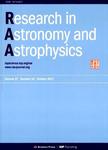What do parameterized Om(z) diagnostics tell us in light of recent observations?
What do parameterized Om(z) diagnostics tell us in light of recent observations?作者机构:Department of Astronomy Beijing Normal University Department of Astrophysics and Cosmology Institute of Physics University of Silesia
出 版 物:《Research in Astronomy and Astrophysics》 (天文和天体物理学研究(英文版))
年 卷 期:2018年第18卷第6期
页 面:49-58页
核心收录:
学科分类:07[理学] 070401[理学-天体物理] 0704[理学-天文学]
基 金:supported by the National Key R&D Program of China (No. 2017YFA0402600) the National Basic Research Program of China (2014CB845800) the National Natural Science Foundation of China (Nos. 11503001, 11690023, 11373014 and 11633001) the Strategic Priority Research Program of the Chinese Academy of Sciences (No. XDB23000000) the Interdisciplinary Research Funds of Beijing Normal University the Opening Project of Key Laboratory of Computational Astrophysics National Astronomical Observatories, Chinese Academy of Sciences supported by the China Postdoctoral Science Foundation (Grant No. 2017M620661) also partly supported by the Poland-China Scientific & Technological Cooperation Committee Project (No. 35-4) supported by the Foreign Talent Introduction Project the Special Fund Supporting Introduction of Foreign Knowledge Project in China
主 题:cosmology: theory cosmology: observations cosmology: cosmological parameters
摘 要:In this paper, we propose a new parametrization for Om(z) diagnostics and show how the most recent and significantly improved observations concerning the H(z) and SN Ia measurements can be used to probe the consistency or tension between the ΛCDM model and observations. Our results demonstrate that H0 plays a very important role in the consistency test of ΛCDM with H(z)data. Adopting the Hubble constant priors from Planck 2013 and Riess, one finds considerable tension between the current H(z) data and ΛCDM model and confirms the conclusions obtained previously by others. However, with the Hubble constant prior taken from WMAP9, the discrepancy between H(z) data and ΛCDM disappears, i.e., the current H(z) observations still support the cosmological constant scenario. This conclusion is also supported by the results derived from the Joint Lightcurve Analysis(JLA) SN Ia sample. The best-fit Hubble constant from the combination of H(z)+JLA(H00 = 68.81+1.5-1.49 km s-1 Mpc-1) is very consistent with results derived both by Planck 2013 and WMAP9, but is significantly different from the recent local measurement by Riess.



